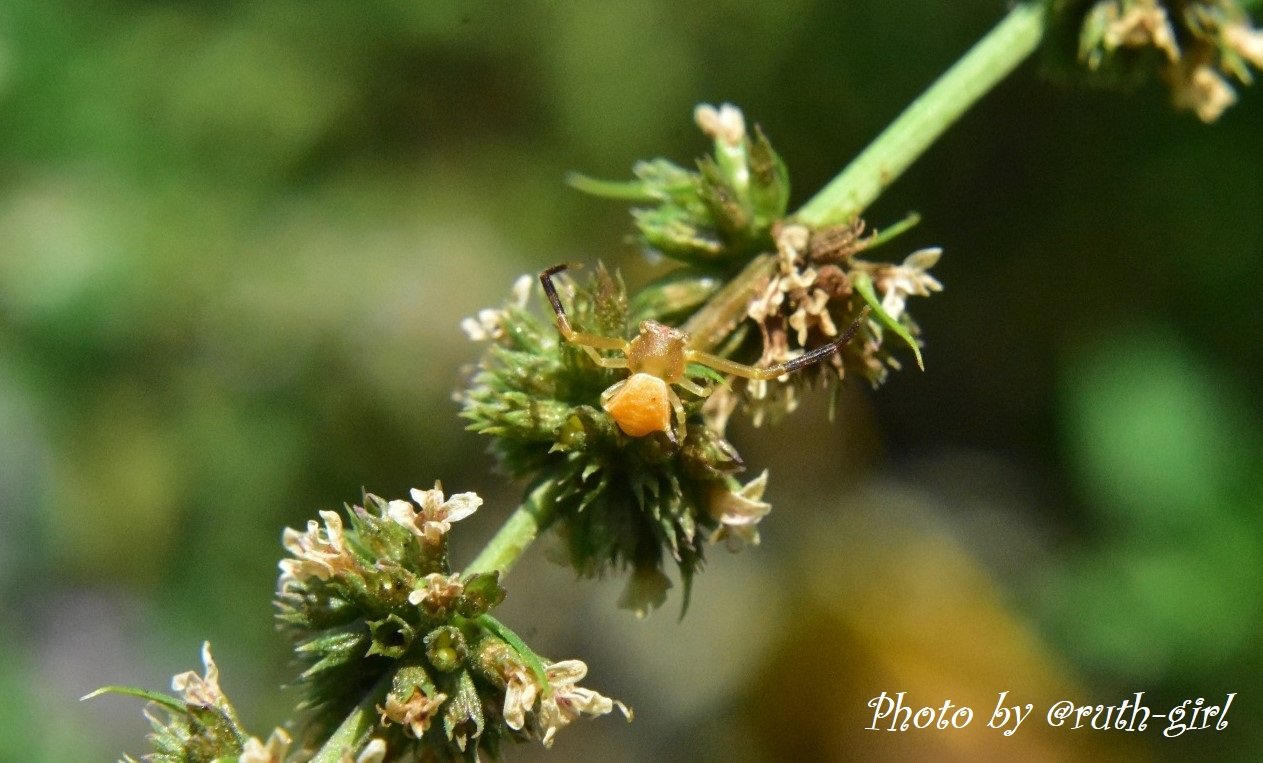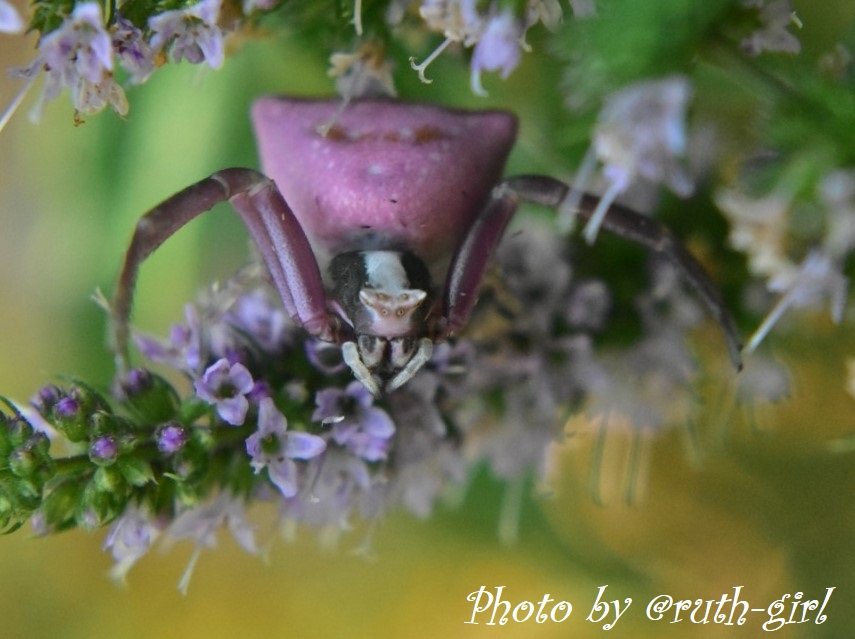Yesterday I showed you two hatches of spiderlings I found in my garden.
Remember?
Today I'll be explaining how we ended up from this...
to this
Get to know the parents
In spiders, sexual dimorphism is a thing. This means that the females are usually larger (sometimes many times larger) and have a "bulkier" opisthosoma than the males. The size difference is due to the fact that females have bigger energy needs, since they are the ones who not only build webs, but have to lay eggs. Males are mostly useful for their sperm and after their "productive input" they are no longer necessary (therefore they're more easily expendable... and edible). [1, 2]
Look! Here is:
A daddy

And a mommy

The steps to spider conception:
The males jerk off before sex!
Yes, you read that right. Male spiders produce sperm webs. They use them to ejaculate on and then use their pedipalps (the leg-like organs next to their mouth) like a "syringe" that sucks and stores the ejaculated sperm until a female is found. The whole process is long and requires patience. Because of that, their pedipalps have bulkier tips, since they keep the sperm inside. [1, 2, 3, 4, 5, 6 ,7]
Have a look at this "masturbating" tarantula
The foreplay before the main action
The whole procedure of mating takes a lot of planning as the male is risking his life (don't forget, sexual cannibalism is a thing for spiders). First he needs her "smell", pheromones that she sprays over her web (secreted by organs on her legs). The scent that they give off will attract males of her species that will identify her as a perfect match and may also let the "men" know how hungry she is. Once he spots her, he will try to approach and "seduce" her. [1, 2, 3, 4, 5, 6 ,7]
Get laid if you know the right moves
Dancing, music and food are tricks used to seduce a female, although for the more BDSM types, even bondage could be applied, as there are some males that "trap" their female in a silk cover they make around her. [1, 2, 3, 4, 5, 6 ,7]
If the lady succumbs to her male's irresistible charms, then he will be allowed to insert his palp inside her epigyne and "pump that sperm out" in a procedure that takes from several seconds to a few hours. The males may even want to "recharge" their pedipalps and have a second go with the same female, once sex is done. There are cases of spiders that leave their palp inside their female so as to block future aspiring Don Juans from fertilizing their lady. While in other cases, the males just run for their life (if they get lucky and don't end up an after-sex-snack), there are always some which willingly march towards the jaws of death of the hungry and huge female. [1, 2, 6]
See this video (spoiler: the leading actor dies in the end)
An exception to the rule would be Harpactea Sadistica. Here, the males just "pierce" the females abdomen and fill her with their sperm. [1]
We got the sperm! Let's make some spiders!
Fertilization happens in two phases. First the male needs to produce his sperm and save it in his palps and then he needs to stick his palps into the female's epigyne (an opening on the down side of the female's abdomen used for receiving sperm). After all that, the female will store the sperm inside her and keep it safe for as long as she needs to lay her eggs. [1, 2, 3, 4, 5, 6 ,7]
Getting those spider eggs out
The eggs will take a while to be released inside the female's body and then laid by the gonopore (an opening under the epigyne). Once the eggs are laid, the epigyne will release the stored sperm and let conception begin! [2, 7]
The eggs are released covered in a sticky "glue". Exposed to air, it starts solidifying enclosing the precious descendants inside them. Around this sphere, a blanket of silk will be weaved so that the egg sac will be easily attached to the mother's web. It is possible for some species to keep their egg sacs hidden inside their nest, while others may have them dragged around, attached on their spinnerets (the silk producing organ on the spider's opisthosoma") or simply carried by their chelicerae (in simple words, the spider's "jaws"). [1, 2, 3, 5, 6 ,7]
Moms will make from one to three sacs that may fit from a couple up to a few thousands of eggs. These sacs are to be hatched in different times. If you remember my post The Crab Spider Family: Revealed, the sacs are made in summer. Those made earlier will hatch in a few weeks and the spiderlings will hibernate until spring comes (at least those who get to survive). The larvae inside the sacs that were weaved later, will wait until next spring or even summer comes and then the little spiderlings will come out. This multiplies the chances of survival for the species. [1, 2, 3, 5, 6 ,7]
The mother of some species will die after delivery, but there are some that stay there to protect their "gene investment", like these ladies from my garden: [1, 2, 5, 7]
Some of them, may even stick around after the spiderlings hatch and care for their children "nutrition" or simply keep an eye on them. There are also species where the females live hidden with their fragile newborns in "shelters" or simply carry them all (!) on their abdomen (οικογενειακά βάρη, family burden it's what we say in Greece). [2, 5, 6 ,7]
When the time is right, the brood will hatch at the same time. Using their fangs, the newborn spiders will crack their egg open and get out. Then they will slowly pierce their way out of their protective cocoons their mother built with such patience and devotion. In some cases, the mother may help her little ones get out of their cocoon, by making the opening herself. Since they are unable to hunt, their eggs will provide them with the nutrients they need for their first days. [2, 5, 7]
After they grow a little and are capable of hunting and making their own silk, the babies will start wandering and spread over the area. [2]
See those little ones? Not all of them will reach maturity about a year later. Sadly most of them will perish in the hands... or better mouth of another predator. But those who'll get lucky will grow to play the parts Mum and Dad played one or two years before them, as life is being played on Repeat...
References
[1] wikipedia.org
[2] biodiversityexplorer.org
[3] sciencing.com
[4] britannica.com
[5] earthlife.net
[6] livescience.com
[7] findaspider.org.au
Images (not free for re-use) by @ruth-girl - Steemit, 2018

Thank you so much for your time!
Until my next post,
Steem on and keep smiling, people!



